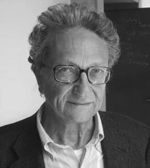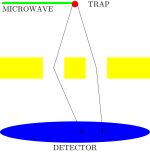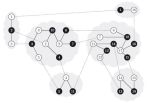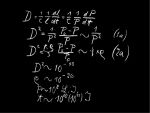News
EPJB Review - New promising bulk thermoelectrics
- Details
- Published on 11 March 2014

The growing need for alternative “green” energy sources has prompted renewed interest in thermoelectric materials. These materials can directly convert heat to electricity or, conversely, use electrical current to cool. The thermoelectric performance of a material can be estimated by the so-called figure of merit, zT = σα2T/λ (α is the Seebeck coefficient, σα2 is the power factor, σ and λ are the electrical and thermal conductivity, respectively), the value of which depends only on the material.
In a new EPJ B review, authors Gonçalves and Godart discuss the state of the art in this field, with special emphasis on the strategies to reduce the lattice part of the thermal conductivity and maximize the power factor in thermoelectric materials.
EPJ B Highlight - Football displays fractal dynamics
- Details
- Published on 05 March 2014

Physicists reveal that the real-time dynamics in a football game are subject to self-similarity characteristics in keeping with the laws of physics, regardless of players’ psychology and training
Football fascinates millions of fans, all of them unaware that the game is subject to the laws of physics. Despite their seemingly arbitrary decisions, each player obeys certain rules, as they constantly adjust their positions in relation to their teammates, opponents, the ball and the goal. A team of Japanese scientists has now analysed the time-dependent fluctuation of both the ball and all players’ positions throughout an entire match. They discovered that a simple rule governs the complex dynamics of the ball and the team’s front-line. These findings , published in EPJ B, could have implications for other ball games, providing a new perspective on sports science.
EPJ D Topical Review: Self-assembling and self-limiting monolayer deposition
- Details
- Published on 26 February 2014
The effect of spatial ordering of molecules on surfaces is commonly utilised to deposit ultra-thin films, where the film thickness is only a few nanometres. In this EPJ D review paper, several methods are discussed that are distinguished from other thin film deposition processes by exactly these effects, leading to self-assembling and self-limiting layer growth and, eventually, to coatings with unique and fascinating properties, and applications in micro-electronics, optics, chemistry, and biology.
EPJ H Highlight - All paths lead to Rome, even the path to condensed matter theory
- Details
- Published on 26 February 2014

Italian physicist Carlo Di Castro shares his thoughts on the development of theoretical condensed matter physics in Rome from the 1960s until the beginning of this century.
Italian physicist Carlo Di Castro, professor emeritus at the University of Rome Sapienza, Italy, shares his recollections of how theoretical condensed matter physics developed in Rome, starting in the 1960s. Luisa Bonolis, a researcher at the Max Planck Institute for the History of Science in Berlin, Germany invited Di Castro to reflect upon his research career, which he did in an interview published in EPJ H.
In this unique document, Di Castro talks about his upbringing during the second World War. He also explains how this childhood experience later influenced his philosophy, which he aptly summarises as follows: “the fear of the unknown must be overcome through knowledge and reason.” Ultimately, this approach guided the career choices that led him to become a condensed matter physicist.
EPJ D Highlight - Patterns of interfering massive particles
- Details
- Published on 26 February 2014

A new study represents a step forward in our understanding of the nature of exchange interactions between identical particles, which only occur at the quantum level
Two-particle interference has been the focus of many studies, specifically in quantum optics with photons. However, interference between two massive, identical particles is not so well understood. In a study published in EPJ D, Pedro Sancho from the CLPU—Centre for Pulsed Lasers—in Salamanca, Spain, uncovers a counterintuitive result whereby particles called bosons do not behave as expected—they are overlapping, and not interfering—due to the combination of interference and so-called exchange interaction. The latter is a quantum mechanical effect that alters their symmetry when identical particles are exchanged.
EPJ Plus Highlight - Carbon dating uncovers forged Cubist painting
- Details
- Published on 19 February 2014

Physicists use carbon dating to confirm alleged Fernand Léger painting was definitely a fake, thus corroborating the doubts about its authenticity previously expressed by art historians
Choosing the right physical technique to analyse paintings can make all the difference when it comes to ascertaining their authenticity. Now, a painting initially attributed as belonging to a series called ‘Contraste de formes’ by French Cubist painter Fernand Léger has definitely been identified as a forgery. This is the first time it has been possible to identify a fake painting by relying on the anomalous behaviour of the concentration of the radioactive form of carbon (14C) in the atmosphere after 1955 to date the canvas. These findings were recently published in EPJ Plus by Mariaelenea Fedi of the National Institute of Nuclear Physics (INFN) in Florence, Italy, and colleagues.
EPJ Plus Highlight - Scaling up renewable energy
- Details
- Published on 19 February 2014

A new study focuses on the feasibility of scaling up renewable energy to cover the needs of a country the size of Germany
Can renewable energy adequately supply the power grid, despite its intermittent nature? This is the key question in a new study published in EPJ Plus. The study is based on an analysis of concrete data from 2012 for the German national grid, which also utilises electricity from both on and offshore wind (8%) and solar sources (4.8%). Friedrich Wagner from the Max-Planck Institute for Plasma Physics in Greifswald, Germany, outlines the key issues associated with the use of renewable energy on a large scale.
EPJ B Highlight - Probing the edge of chaos
- Details
- Published on 18 February 2014

To understand natural phenomena with a chaotic nature, the key is to find out how their variable physical characteristics behave at the very point preceding the onset of chaos
The edge of chaos—right before chaos sets in—is a unique place. It is found in many dynamical systems that cross the boundary between a well-behaved dynamics and a chaotic one. Now, physicists have shown that the distribution—or frequency of occurrence—of the variables constituting the physical characteristics of such systems at the edge of chaos has a very different shape than previously reported distributions. The results have been published in EPJ B by Miguel Angel Fuentes from the Santa Fe Institute in New Mexico, USA, and Universidad del Desarrollo, Chile, and Alberto Robledo from the National Autonomous University of Mexico, Mexico City. This could help us better understand natural phenomena with a chaotic nature.
EPJ B Highlight - Optimising custody is child’s play for physicists
- Details
- Published on 11 February 2014

Ensuring that parents in recomposed families see their children regularly is a complex network problem that models developed to study materials may help to solve
Physics can provide insights into societal trends. Problems involving interactions between people linked in real-life networks can be better understood by using physical models. As a diversion from his normal duties as a theoretical physicist, Andrés Gomberoff from the Andres Bello University, in Santiago, Chile, set out to resolve one of his real-life problems: finding a suitable weekend for both partners in his recomposed family to see all their children at the same time. He then joined forces with a mathematician and a complex systems expert. This resulted in a study published in EPJ B, showing that solving this problem essentially equates to minimising the energy in a material model.
EPJ H Highlight - Einstein’s forgotten model of the universe
- Details
- Published on 05 February 2014

New insights into Einstein’s view of the cosmos from the translation and study of one of his least known papers
A paper published in EPJ H provides the first English translation and an analysis of one of Albert Einstein’s little-known papers, “On the cosmological problem of the general theory of relativity”. Published in 1931, it features a forgotten model of the universe, while refuting Einstein’s own earlier static model of 1917. In this paper, Einstein introduces a cosmic model in which the universe undergoes an expansion followed by a contraction. This interpretation contrasts with the monotonically expanding universe of the widely known Einstein-de Sitter model of 1932.




